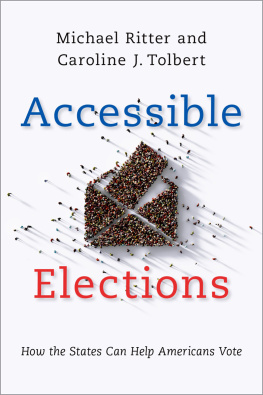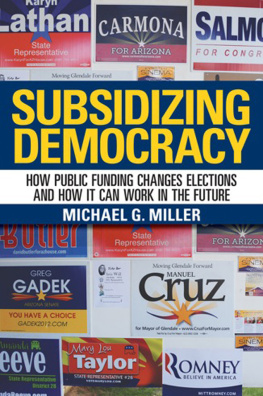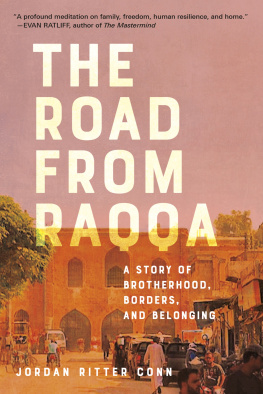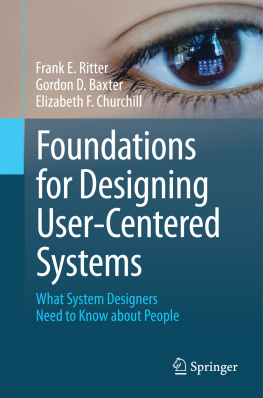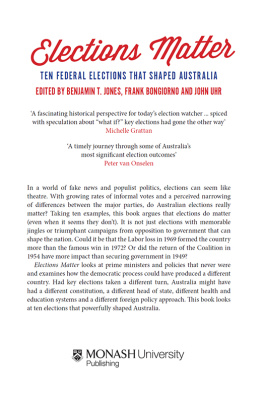Michael Ritter - Accessible Elections
Here you can read online Michael Ritter - Accessible Elections full text of the book (entire story) in english for free. Download pdf and epub, get meaning, cover and reviews about this ebook. year: 2020, publisher: OUP Premium, genre: Politics. Description of the work, (preface) as well as reviews are available. Best literature library LitArk.com created for fans of good reading and offers a wide selection of genres:
Romance novel
Science fiction
Adventure
Detective
Science
History
Home and family
Prose
Art
Politics
Computer
Non-fiction
Religion
Business
Children
Humor
Choose a favorite category and find really read worthwhile books. Enjoy immersion in the world of imagination, feel the emotions of the characters or learn something new for yourself, make an fascinating discovery.
- Book:Accessible Elections
- Author:
- Publisher:OUP Premium
- Genre:
- Year:2020
- Rating:5 / 5
- Favourites:Add to favourites
- Your mark:
- 100
- 1
- 2
- 3
- 4
- 5
Accessible Elections: summary, description and annotation
We offer to read an annotation, description, summary or preface (depends on what the author of the book "Accessible Elections" wrote himself). If you haven't found the necessary information about the book — write in the comments, we will try to find it.
Accessible Elections — read online for free the complete book (whole text) full work
Below is the text of the book, divided by pages. System saving the place of the last page read, allows you to conveniently read the book "Accessible Elections" online for free, without having to search again every time where you left off. Put a bookmark, and you can go to the page where you finished reading at any time.
Font size:
Interval:
Bookmark:


Oxford University Press is a department of the University of Oxford. It furthers the Universitys objective of excellence in research, scholarship, and education by publishing worldwide. Oxford is a registered trade mark of Oxford University Press in the UK and certain other countries.
Published in the United States of America by Oxford University Press
198 Madison Avenue, New York, NY 10016, United States of America.
Oxford University Press 2021
All rights reserved. No part of this publication may be reproduced, stored in a retrieval system, or transmitted, in any form or by any means, without the prior permission in writing of Oxford University Press, or as expressly permitted by law, by license, or under terms agreed with the appropriate reproduction rights organization. Inquiries concerning reproduction outside the scope of the above should be sent to the Rights Department, Oxford University Press, at the address above.
You must not circulate this work in any other form and you must impose this same condition on any acquirer.
Library of Congress Cataloging-in-Publication Data
Names: Ritter, Michael, author. | Tolbert, Caroline J., author.
Title: Accessible elections : how the states can help Americans vote /
Michael Ritter, Caroline J. Tolbert.
Description: New York : Oxford University Press, 2020. |
Includes bibliographical references and index.
Identifiers: LCCN 2020022211 (print) | LCCN 2020022212 (ebook) |
ISBN 9780197537251 (hardback) | ISBN 9780197537275 (epub) |
ISBN 9780197537282 (online) | ISBN 9780197537268 (updf)
Subjects: LCSH: VotingUnited States. | ElectionsUnited States. |
Voter turnoutUnited States.
Classification: LCC JK1967 .R57 2020 (print) | LCC JK1967 (ebook) |
DDC 324.6/5dc23
LC record available at https://lccn.loc.gov/2020022211
LC ebook record available at https://lccn.loc.gov/2020022212
Dedicated to Laura Kuhlman
Bert and Anne Tolbert
In the wake of the 2020 Covid-19 public health crisis, U.S. governors have taken on a new leadership role. Under federalism, state governments led the fight to limit the spread of the disease with policies ranging from banning large gatherings, to closing schools, restaurants and bars, and non-essential businessesprofoundly changing daily routines and the economy. But before the health crisis state governments were leading the way in making it easier to vote in elections in an effort to strengthen democratic government. Accessible Elections underscores how state governments can modernize their electoral systems to increase voter turnout and influence campaign and party mobilization strategies. Many scholars have dismissed state election reform lawscommonly referred to as convenience methodsas failing to significantly increase turnout or address inequality in who votes. As a recent FiveThirtyEight headline reads, early voting laws probably dont boost turnout ().
Rather than focus on individual laws in isolation, this book develops the concept of accessible elections, defined as the combination of each states voting and registration laws and past performance in administering elections in order to ensure that all eligible voters are able to participate. Election administration includes the registration of voters, counting of ballots, polling place access for disabled citizens, vote waiting time, online information on polling places, variation in voting machines, difference between ballots cast and votes counted, and more (Pew 2016; Burden and ). The existing research has not measured electoral features that include the laws and election administration. This study re-evaluates what state governments can do to increase participation rates for the American people, with additional emphasis given to the poor and racial and ethnic minorities. Using a data driven approach to measure electoral practices and voter turnout, our results suggest state election reform efforts do make a positive difference.
Reform of Americas election rules is long overdue. Use of alternative or convenience methods to in-person election day voting reached a high point in 2018, with 40% of election ballots cast.
The 2020 election promises to be higher. Yet much of the core research in the field of voting rights and state voting/registration laws in the U.S. has not been updated to reflect current realities.
The last few decades have witnessed widespread changes in state election laws. In many states new technology has given individuals the ability to use the internet or their cell phones to become registered voters, request absentee ballots, and identify polling locations, changing the process of how people vote. Adding to these changes are recent state adoptions of same day registration, automatic voter registration, early voting, mail voting, and no-excuse absentee voting. Much of the published research was conducted when these laws were nascent. More than a decade later this study re-examines the effects of state voting laws, combined with election administration, to understand how state governments can make voting more or less accessible for the American people.
The message from much of the published literature is that state voting reform lawsespecially early voting, and mail and no excuse absentee votinggenerally benefit educated, older and more affluent people rather than disadvantaged demographic groups, as our research shows. Although same day registration has been shown to have positive benefits, one cannot understand the real effects of these laws without consideration of the implementation of the laws. The research design used here helps account for possible selection bias in why some states adopt voting reforms in the first place, by controlling for states with historically high or low turnout and their past performance in administering elections.
Much of the earlier work was based on more limited data, did not control for election administration (how well the states conduct elections) and did not include vote histories from the same people over time. Without vote histories, these earlier studies could not isolate whether state election laws were linked to changes in individual voting rates. With improved data, research design and statistical methods, we are able to learn more about how these new state laws effect voter turnout, and turnout by historically disadvantaged groups.
The current study uses national voter files with millions of cases and vote histories of the same individuals to detect change in political participation over time. Use of state voter rolls and panel data helps improve the study election reform by making the results more reliable. Panel designs with repeated measurements of voting over time are used to evaluate the effects of the state voting laws and develop improved predictive models. When measuring change in turnout over time for individuals, the results tell us a different story than much of the published research.
Empirical results show that how well state governments run elections matters, a factor generally overlooked in the voting literature. State election administration performance is a strong predictor of voter turnout in both midterm and presidential elections, and uniquely benefits the voting decisions of racial and ethnic minorities, and even the poorest of citizens. Of the voting laws, same day registration has the greatest effect in increasing overall turnout as well as turnout of the poor and racial minorities in both midterm and presidential elections. The effects are larger than reported in previous research. No-excuse absentee voting and mail voting also helps convert non-voters into voters in presidential elections. Early voting, largely dismissed in the election sciences literature, increases turnout in midterm elections, and even enables higher participation by racial minorities. Changing the rules of game is an important tool in addressing inequality.
Font size:
Interval:
Bookmark:
Similar books «Accessible Elections»
Look at similar books to Accessible Elections. We have selected literature similar in name and meaning in the hope of providing readers with more options to find new, interesting, not yet read works.
Discussion, reviews of the book Accessible Elections and just readers' own opinions. Leave your comments, write what you think about the work, its meaning or the main characters. Specify what exactly you liked and what you didn't like, and why you think so.

